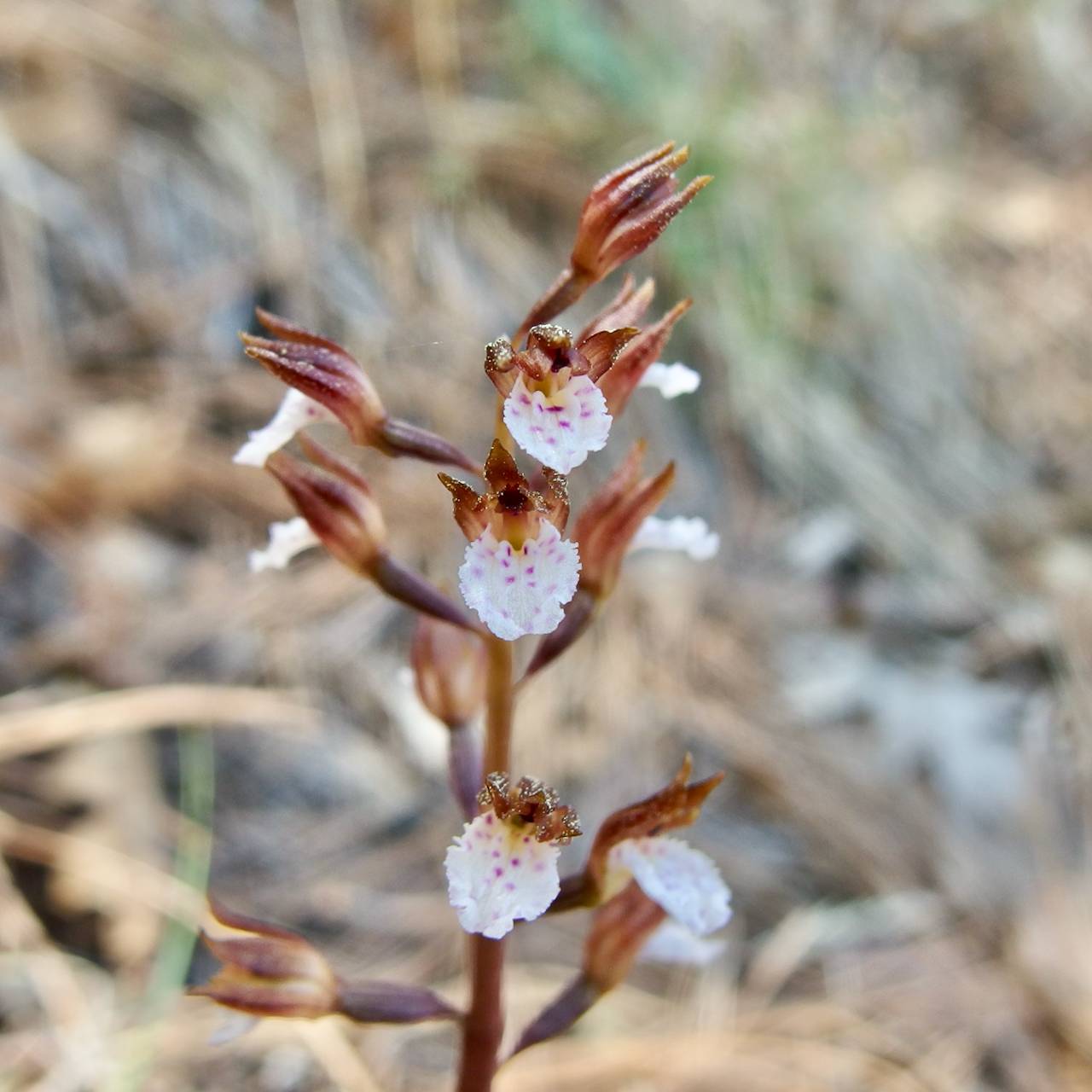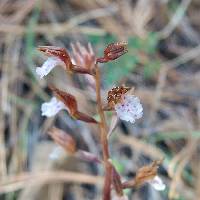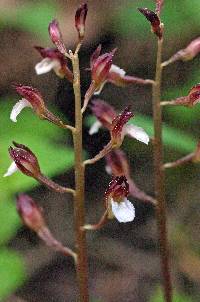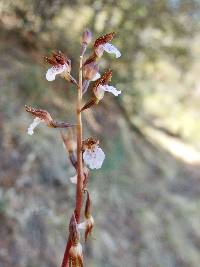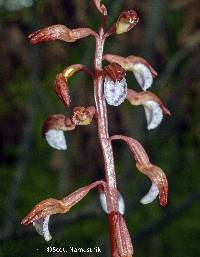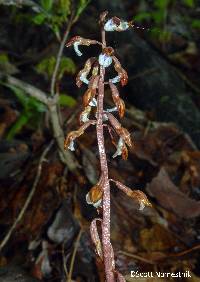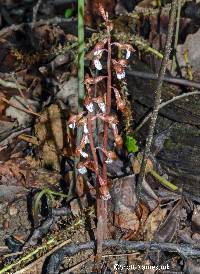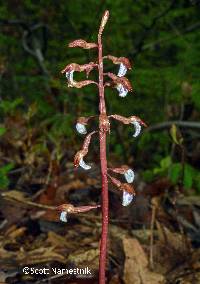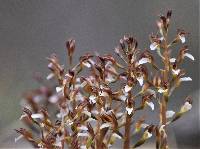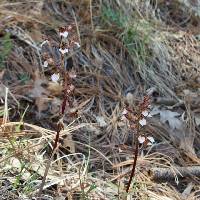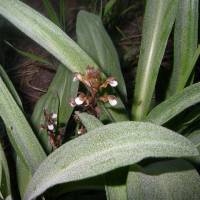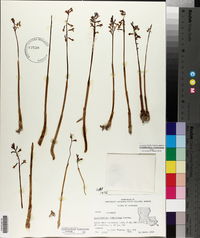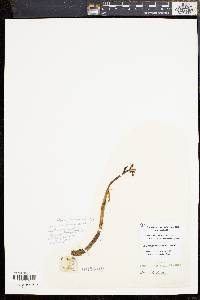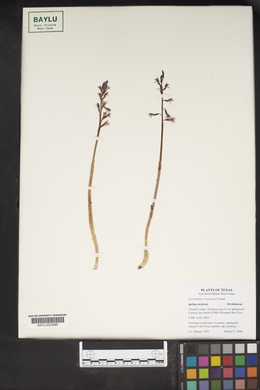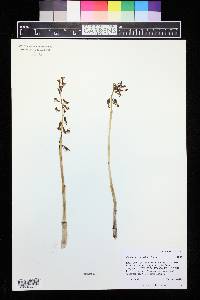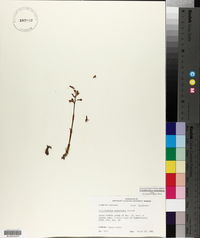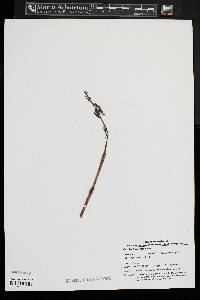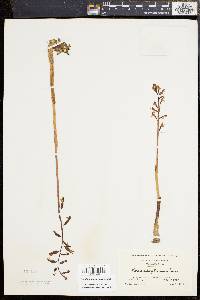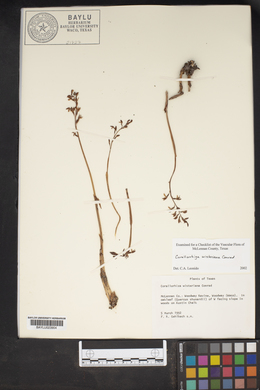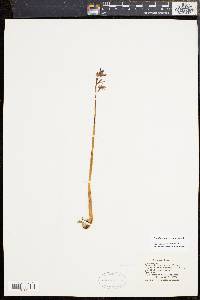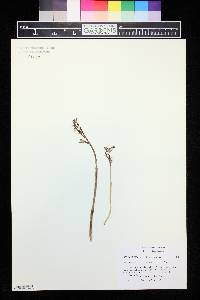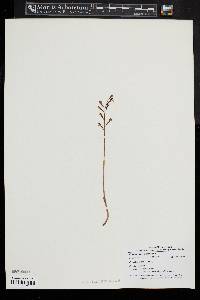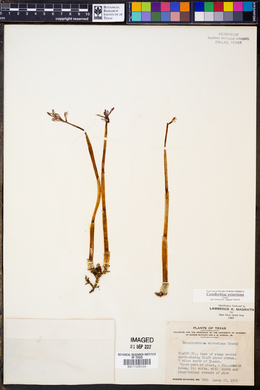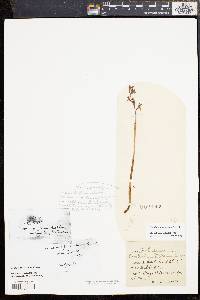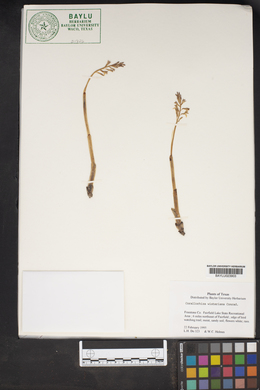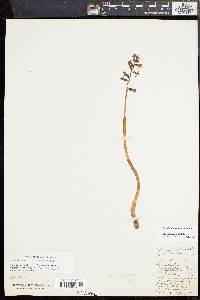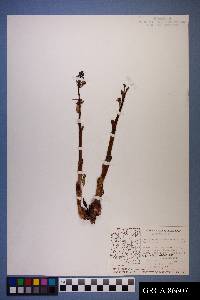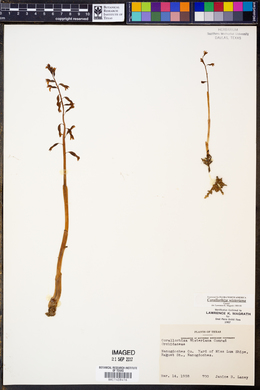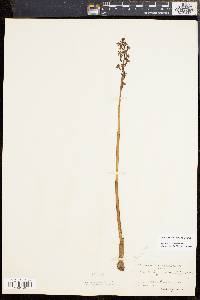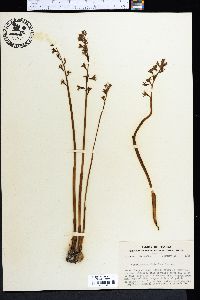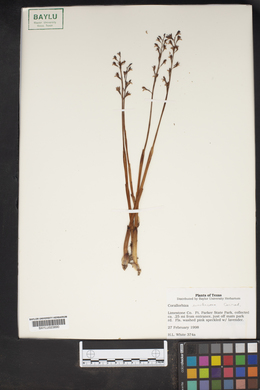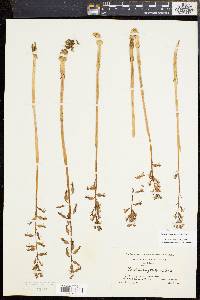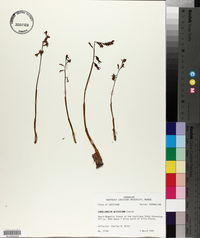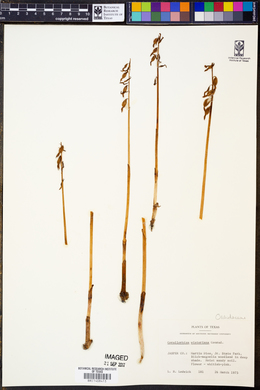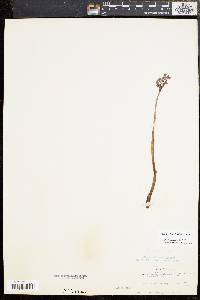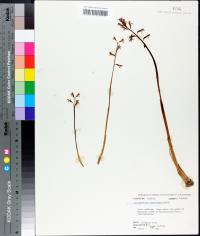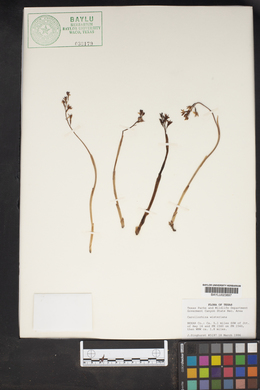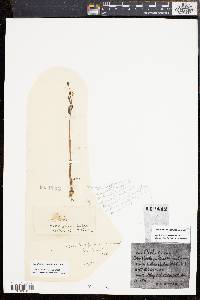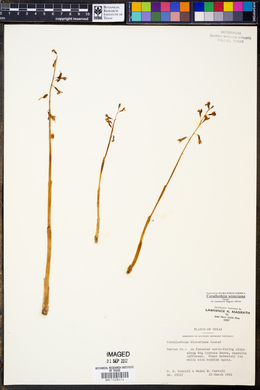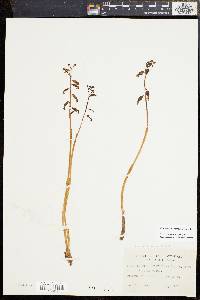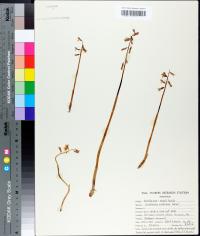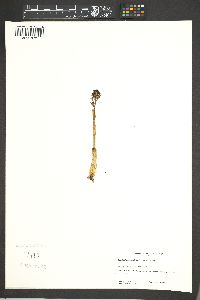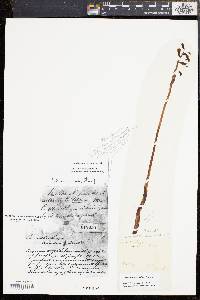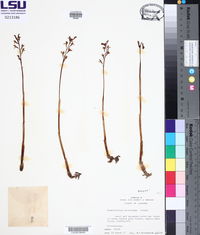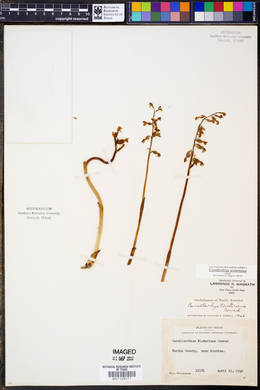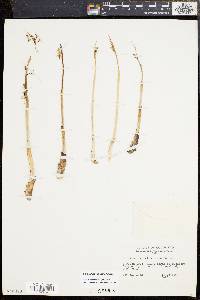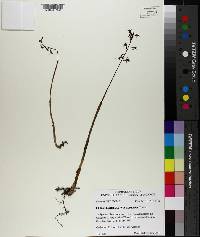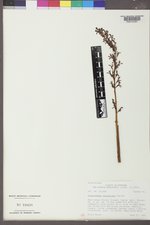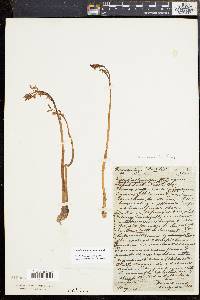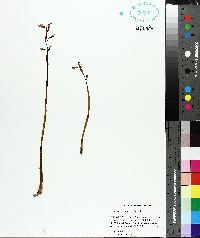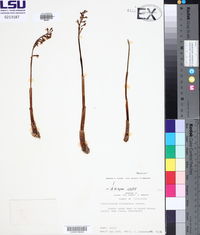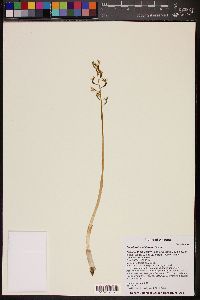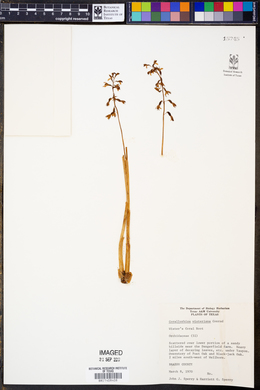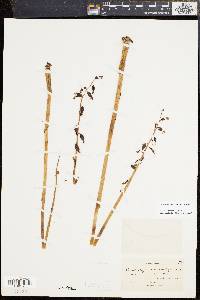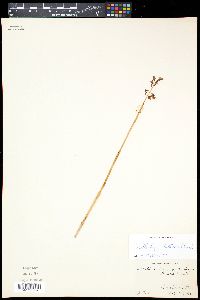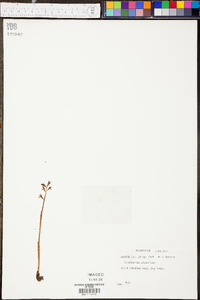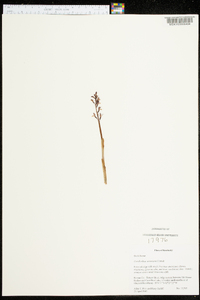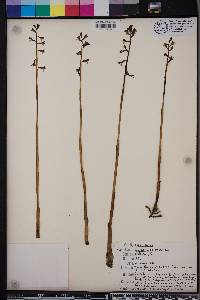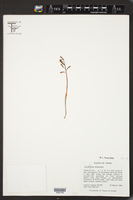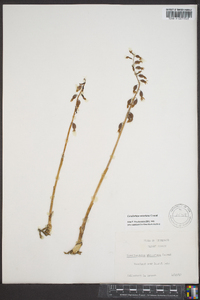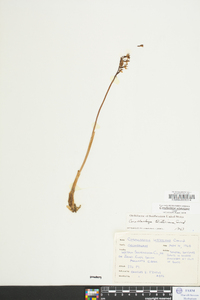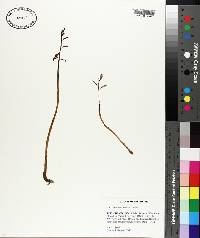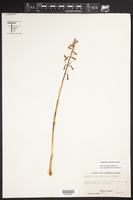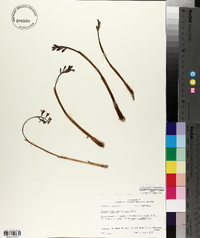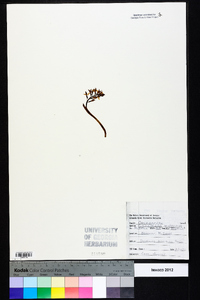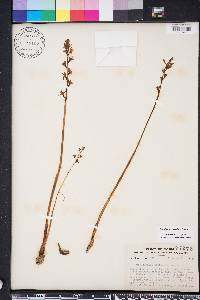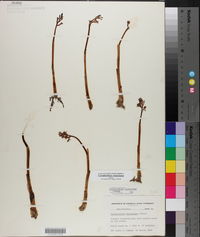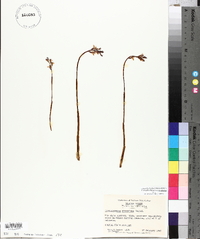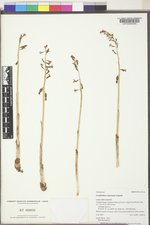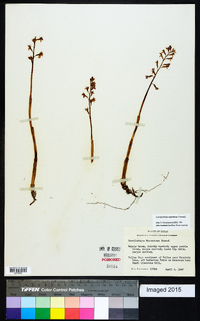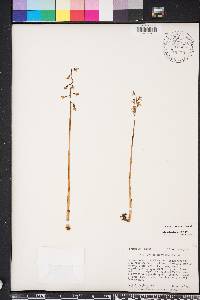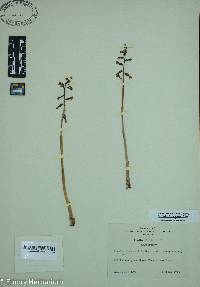Corallorhiza wisteriana
|
|
|
|
Family: Orchidaceae
Spring Coralroot, more...coralroot
[Corallorhiza elliptica Schltr., moreCorallorhiza hortensis Suksd., Corallorrhiza wisteriana Conrad] |
Stems red-purple to yellowish brown to yellow, base not strongly thickened nor bulbous. Inflorescences: racemes lax to dense, 10-55 × 1.3-3.5 cm. Flowers 2-25, inconspicuous; perianth open; sepals and petals purplish brown, often greenish distally, or pure yellow, 3-veined; sepals lanceolate, 4.5-10 mm; lateral sepals upcurved, connivent with dorsal sepal and petals, forming hood over column, somewhat falcate; petals often spotted with purple, broadly lanceolate, 4-7.2 mm; lip white, often spotted with purple, ovate to suborbiculate, unlobed, 4-7.5 × 2.5-7.5 mm, with 2 distinct basal lamellae, margins erose-denticulate to nearly entire; column curved toward lip, yellow to white, often with purplish apex, 2.4-5 mm, with basal auricles; ovary 3-8 mm; mentum present. Capsules ellipsoid-obovoid, 7-14 × 3.5-6.2 mm. Flowering Jan--Jul, according to latitude. Deciduous and coniferous woods, often preferring richer habitats than other coral-roots; 0--3100 m; Ala., Ariz., Ark., Colo., Del., D.C., Fla., Ga., Idaho, Ill., Ind., Kans., Ky., La., Md., Miss., Mo., Mont., Nebr., N.J., N.Mex., N.C., Ohio, Okla., Pa., S.C., S.Dak., Tenn., Tex., Utah, Va., Wash., W.Va., Wyo.; Mexico. Western collections of Corallorhiza wisteriana have frequently been misidentified as C. maculata. Antho-cyanin-free forms from the central states have been misidentified as C. trifida.
Perennial mycotrophic (saprophytic) herb 10 - 40 cm tall Leaves: none. Inflorescence: a single, erect, terminal, stalked, loose, short to elongate (2 - 30 cm), spike-like cluster of two to twenty, stalked, inconspicuous flowers with each flower subtended by a minute bract. Flowers: somewhat horizontal, yellowish brown to purplish, spotted with purple, 1 - 2 cm long, bilaterally symmetric, lacking a spur, sepals and lateral petals pointed upwards and converging to form a hood over lower petal, which is formed into a protruding, arched, downward curved lip. The reproductive parts of stamens, stigma and style are fused into a 2.4 - 5 mm long column above the 3 - 8 mm long inferior ovary. Column arched and curved toward lip, yellow to white, often purplish toward tip. Sepals: three, petal-like, yellowish brown to purplish, sometimes entirely yellow or greenish near tips, always with three darker nerves, and all pointed upward and closely positioned with lateral petals. The central sepal is 6 - 9 mm long, 1.5 - 2 mm wide, and linear with a blunt or pointed tip. Two lateral sepals 4.5 - 9 mm long, 1 - 2 mm wide, and linear to lance-shaped. Petals: three, upper two converging with sepals to form upward pointed hood over lower, protruding lip. The two lateral petals are 4 - 7 mm long (shorter than sepals), 1 - 2 mm wide, broadly lance-shaped to oblong, pointed at the apex, yellow to purple-brown or greener near the tips, and often spotted with purple. Lip somewhat horizontal but curving out and down, 4 - 7 mm long, 2.5 - 6.5 mm wide, unlobed, egg-shaped or elliptic to almost circular, white with purple spots, and weakly rippled and irregularly toothed along edges. Near the base of the lip petal there are two obvious linear, lengthwise ridges (lamellae). Fruit: several, stalked, 0.7 - 1.2 cm long, 3.5 - 6 mm wide, egg-shaped (or inversely so) to ellipsoid capsules. Flowering stem: single, erect, slender to moderately stout, hairless, fleshy, reddish brown to dark purple or even yellowish, lacking leaves, but with a few, pale, tubular sheaths. This leafless structure terminated by flowers is called a scape and technically is not a true stem. Root system: lacking true roots, but with multiple-branched, coral-like rhizomes. Similar species: Corallorhiza wisteriana is somewhat similar to C. odontorhiza and its varieties, but that species has a shorter central sepal (under 4.5 mm) with only one vein, the flowers are typically more closed, and it blooms in fall, not early spring. Often C. wisteriana is misidentified as C. maculata or C. trifida, but both of those species have two small lateral lobes or teeth on the lip petal, and the lateral sepals are not upcurved, but rather spreading or curved downward. Flowering: April to June Habitat and ecology: Extremely rare, only known from St. Joseph Co., IN in damp woods. Just south of our area it is found in rich mesic woodlands and dry-mesic areas with oak and hickory and ample covering of leaf litter. Occurence in the Chicago region: native Notes: Corallorhiza wisteriana has a much more southern distribution, and aside from the disjunct population collected in St. Joseph Co., IN, the nearest populations are in La Salle Co., IL, just south of the Chicago Region. However this is still about 100 miles north from the rest of the more contiguous populations of the species. Yet it is not entirely implausible that populations may exist in the dune region of Indiana waiting to be discovered. The major barrier to sustainable populations in our area may be the presumed inability of C. wisteriana to tolerate cold since the species range is mostly south of Pleistocene glaciated areas (Homoya 1993). Etymology: Corallorhiza comes from the Greek words korallion, meaning coral, and rhiza, meaning root, in reference to the branching, underground rhizome, which has a similar appearance to coral. Wisteriana is named in honor of American botanist Charles Wister. Author: The Field Museum Stem 1-4 dm, purple or reddish; infl 3-7 cm, with 10-15 fls; sep and lateral pet extending forward over the column, scarcely spreading, narrowly lanceolate, 5-7.5 mm, greenish-yellowish, tinged with purple and marked with short purple lines; lip deflexed, about as long as the sep, narrowed below into a slender claw more than half as long as the blade, the latter broadly oval, crenulate, notched at the rounded summit, white, dotted with purple. Damp woods; Pa. and s. N.J. to Fla., w. to se. Nebr., Okla., and Tex., and in the w. cordillera. Apr.-June. Gleason, Henry A. & Cronquist, Arthur J. 1991. Manual of vascular plants of northeastern United States and adjacent Canada. lxxv + 910 pp. ©The New York Botanical Garden. All rights reserved. Used by permission. From Flora of Indiana (1940) by Charles C. Deam Infrequent and rather local in the southern third of the state, rarely in small colonies, but, where found, the specimens are usually a rod or more apart. It grows in humus, generally on wooded, beech slopes, sometimes in black or black and white oak woods, and rarely in white oak woods. This is by far our most common coralroot. |
|
|
|

